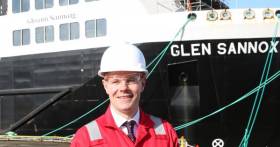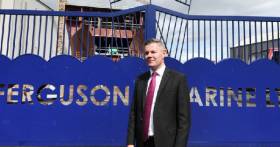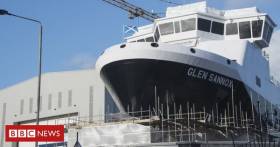Displaying items by tag: Fergusan Marine
Turnaround Boss of Ferguson Marine Leaves Before Delayed Scottish Ferries Finished
The boss brought in to turn around the fortunes of the nationalised Scottish shipyard building the delayed CalMac ferries is leaving his post.
Tim Hair has earned almost £1.3m for 454 days’ work since being appointed to lead Ferguson Marine by the Scottish Government in 2019.
His income makes him one of the UK’s highest-paid public officials, earning more than four times the salary of the First Minister. He previously defended himself telling STV News it was “value for money”.
But Mr Hair will depart the shipyard in February 2022, with the timetable for two lifeline ferries (for Arran and Uig) running over four years late at a cost of more than double the agreed £97m “fixed price”.
It follows the yard losing out to four foreign yards to tender for two ferries to serve Islay and Jura, meaning the vessels will not be constructed in Scotland.
STV news has more on the Clydeside shipyard.
Shipyard Ferguson Marine 'Forced Into Administration' by Scottish Government
On Clydeside a troubled shipyard was "forced into administration" by the Scottish Government without giving the private sector time to save it, a dossier compiled by its former owner has claimed.
Ferguson Marine, the last yard in Scotland still handling non-defence orders, was nationalised by Holyrood ministers late last year after a contract to build two new ferries was beset by massive delays and cost overruns.
Jim McColl, the Monaco-based billionaire who took charge of the shipyard in 2014 through his Clyde Blowers company, has been critical of how the Scottish Government has handled the debacle.
A dossier, compiled by a QC on McColl's behalf, has now claimed Nicola Sturgeon's failure to mediate between Fergusons bosses and government quango Caledonian Maritime Assets Ltd (CMAL) led to the yard's collapse and left taxpayers picking up the bill.
For more on the story HERE reports The Scotsman on the duel-fuel ferries destined for Isle of Arran and Uig Triangle services.
Scottish Shipyard On the Clyde Taken Into Public Ownership
Shipyard Ferguson Marine has officially been taken into public ownership, the Scottish Government has announced.
The move, reports STV News, came on Tuesday after administrators agreed the final terms of the transaction with Scottish Ministers.
The yard will now be known as Ferguson Marine (Port Glasgow) Ltd.
There had been three other offers for the Inverclyde site, however administrators concluded the sale to the Scottish Government represented the best outcome for creditors.
Staff at the shipyard have been told of the latest position.
For more click here to read.
A contract has been signed by the Scottish Government to take the troubled Ferguson Marine shipyard into public ownership, reports The National.
It follows an agreement reached last month for the Government to take over the yard after the firm entered administration in August. A meeting of the board of directors of Macrocom – the company wholly owned by Scottish ministers that will own the Ferguson Marine business and assets – was held yesterday to consider and sign the contract.
Full completion of the contract and the final transaction is expected to take place in the coming weeks.
Finance Secretary Derek Mackay said the action taken would help to ensure a future for the yard. “Our focus has always been on ensuring completion of the two public sector ferries at the best value for money for the taxpayer, while also working towards the delivery of the other vessels under construction at the yard, and in doing so, securing jobs for the workforce,” he said.
More on the story here.
Workforce At Scottish Shipyard Ferguson Marine Boosted As it Battles to Complete Ferries
An increase in employment is a pledge at the nationalised Ferguson Marine shipyard which has resulted in 17 new jobs, with a further ten to be recruited, the Scottish Government announced today.
The yard, reports The Scotsman, is in the final legal process of being taken into public ownership, will also see 14 apprentices complete their training this month, who will be taken into the workforce, as it battles to get the construction of two overdue ferries completed.
The future of the Clyde yard was plunged into doubt earlier this year, after a bitter stand-off with publicly-owned ferry firm Cal Mac over construction of two new ships. Costs on the original £97m contract spiralled with neither side prepared to meet the additional bill, resulting in administrators being called in.
To read more on the revived shipyard click the link.
In Scotland, the last civilian shipyard on the Clyde, The Herald reports, is to be nationalised by the country's Government within a month after a search for a commercial saviour failed.
Workers at Ferguson Marine in Port Glasgow, which was driven into insolvency by a calamitous contract for two CalMac ferries, were told of the development this morning.
The government has already written off almost £50m in loans and interest to the business.
The Scottish Tories called if “potentially disastrous” for Scotland’s shipbuilding industry.
Clink link for more on this story.





























































